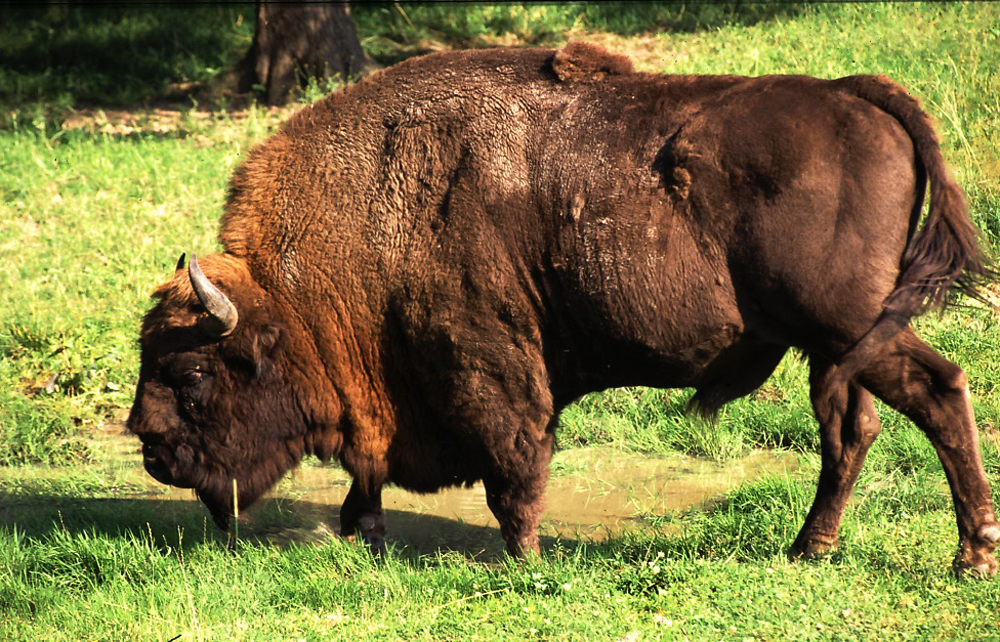- Wisent
Taxobox
name = Wisent
status = EN
status_system = iucn2.3

image_width = 250px
regnum =Animal ia
phylum = Chordata
classis =Mammal ia
ordo =Artiodactyla
familia =Bovidae
genus = "Bison ""'
species = "B. bonasus"
binomial = "Bison bonasus"
binomial_authority = (Linnaeus, 1758)The wisent (pronEng|ˈviːzənt), or European bison ("Bison bonasus"), is abison species and the heaviest surviving land animal inEurope . A typical wisent is about 2.9–3.0 m (9.5 ft) long and 1.8–2.2 m (5.9–7.4 ft) tall, and weighs 300–920 kg (660–2000 lb). It is typically smaller than the relatedAmerican bison ("Bison bison"), and has shorter hair on the neck, head, and forequarters, but longer tail and horns. Wisent are now forest-dwelling. They have few predators (besides humans) with only scattered reports from the 1800s ofwolf andbear predation. Wisent were first scientifically described byCarolus Linnaeus in 1758. Some later descriptions treat the wisent asconspecific with theAmerican bison . It is not to be confused with theaurochs , the extinct ancestor of domestic cattle.In 1996 the
IUCN classified the wisent as anendangered species . In the past it was commonly killed to producehides anddrinking horn s, especially during theMiddle Ages .Near-extinction
About 2000 years ago, wisent lived throughout most of Europe - from Britain in the west, to
Siberia in the east, and fromSpain in the south, toSweden in the north. Wisent lived not only inforest s but also roamedgrassland s.In
Western Europe , wisent becameextinct by the 11th century, except in theArdennes , where they lasted into the 14th century. The last wisent inTransylvania died in 1790. In the east, wisent were legally the property of the Polish kings, Lithuanian grand dukes and Russian czars. KingSigismund I of Poland instituted thedeath penalty forpoaching a wisent in the mid-16th century. Despite these measures, and others, the wisent population continued to decline over the following four centuries. The last wild wisent in Poland was killed in 1919 and the last wild wisent in the world was killed by poachers in 1927 in theWestern Caucasus . By that year fewer than 50 remained, all inzoo s.In order to help manage this captive population, Dr. Heinzel Heck commenced the first
studbook for a non-domestic species; first as a card index from 1923 with a full publication in 1932. [cite book|last=Tudge|first=Colin|year=1992|title=Last Animals at the Zoo|publisher=Island Press|location=Washington, D.C.|isbn=1-5596-3158-9]Reintroduction
Wisent were reintroduced successfully into the wild, beginning in 1951. They are found living free-ranging in forest preserves like
Western Caucasus andPrioksko-Terrasny Nature Reserve inRussia andBiałowieża Forest inPoland andBelarus .Free-ranging herds are found in
Poland ,Lithuania ,Belarus ,Ukraine ,Romania ,Russia ,Slovakia ,Latvia ,Kyrgyzstan and since 2006 inMoldova Fact|date=June 2008. There are plans to re-introduce two herds in northern Germany Clarifyme|date=March 2008. Zoos in 30 countries also have quite a few animals. There were 3,000 individuals (as of 2000), all descended from only 12 individuals. Because of their limited genetic pool, they are considered highly vulnerable to diseases likefoot and mouth disease .More details
Wisent have lived as long as 28 years in captivity although in the wild their lifespan is shorter. Productive breeding years are between four and 20 years old in females and only between six and 12 years old in males. Wisent occupy home ranges of as much as 100 square kilometers and some herds are found to prefer meadows and open areas in forests.
Wisent can cross-breed with
American bison . The products of a German interbreeding program were destroyed afterWorld War II . This program was related to the impulse which created theHeck cattle . The cross-bred individuals created at other zoos were eliminated from breed books by the 1950s. A Russianback-breeding program resulted in a wild herd of hybrid animals which presently lives in theCaucasian Biosphere Reserve (550 individuals in 1999).There are also wisent-cattle hybrids. Cattle and wisent can hybridise fairly readily, but the calves cannot be born naturally (birth is not triggered correctly by the first-cross hybrid calf, and they must therefore be born by
Caesarian section ). In 1847 a herd of wisent-cattle hybrids namedżubroń was created byLeopold Walicki . The animal was intended to become a durable and cheap alternative to cattle. The experiment was continued by researchers from thePolish Academy of Sciences until the late 1980s. Although the program resulted in a quite successful animal that was both hardy and could be bred in marginal grazing lands, it was eventually discontinued. Currently the only surviving żubroń herd consists of just a few animals inBiałowieża Forest , Poland.Three sub-species have been identified:
*
Lowland wisent - "Bison bonasus bonasus" (Linnaeus, 1758) – from Białowieża Forest
* Hungarian (Carpathian) wisent ("Bison bonasus hungarorum") - extinct
*Caucasus wisent ("Bison bonasus caucasicus") - extinct, although one individual fromWestern Caucasus , a bull named "Kaukasus" was one of the 12 founders of the modern herdsThe modern herds are managed as two separate lines - one consisting of only "Bison bonasus bonasus" (all descended from only seven animals) and one consisting of all 12 ancestors including the one "Bison bonasus caucasicus" bull. Only a limited amount of
inbreeding depression from thepopulation bottleneck has been found, having a small effect on skeletal growth in cows and a small rise in calf mortality. Genetic variability continues to shrink. From five initial bulls, all current wisent bulls have one of only two remainingY chromosome s.ee also
*
List of extinct animals of Europe References
Cited sources
General sources
* Listed as Endangered (EN A2ce, C2a v2.3)
External links
* [http://pl.wikipedia.org/wiki/%C5%BBubr Polish wikipedia page about the wisent (żubr)]
* [http://www.worlddeer.org/bison-in-sauerland The reintroduction of bison into Germany] .
*ARKive - [http://www.arkive.org/species/GES/mammals/Bison_bonasus/ images and movies of the European bison ("Bison bonasus")]
* [http://www.press.jhu.edu/books/walkers_mammals_of_the_world/artiodactyla/artiodactyla.bovidae.bison.html Bison entry] from "Walker's Mammals of the World "
* [http://www.petermaas.nl/extinct/speciesinfo/caucasianbison.htm The Extinction Website - Caucasian European bison ("Bison bonasus caucasicus")] .
* [http://www.petermaas.nl/extinct/speciesinfo/carpathianbison.htm The Extinction Website - Carpathian European bison ("Bison bonasus hungarorum")] .
* [http://www.ultimateungulate.com/Artiodactyla/Bison_bonasus.html European bison/wisent]
Wikimedia Foundation. 2010.
